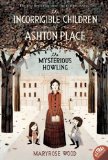Summary | Excerpt | Reading Guide | Reviews | Beyond the Book | Read-Alikes | Genres & Themes | Author Bio

The Incorrigible Children of Ashton Place, Book I
by Maryrose WoodThis article relates to The Mysterious Howling
The childcare arrangements of the nineteenth-century British upper crust have spawned a dynasty of classic literary characters. Can you tell your nursemaids from your nannies, your tutors from your governesses?
Nurse was in charge of the nursery regime - the diapers, the baths, and, especially in the case of the wet nurse, the nourishment. Polly Toodle of Dickens's Dombey and Son is a classic wet nurse, standing in place of a mother and passing on a bit of lower-class affection along with her milk. Nursemaids were nurse's underlings and probably got the nastiest jobs.
The word "nanny" is a close synonym of "nurse", and may derive from a babytalk diminutive. Nannies are the snuggly presences in nursery lore, the workhorses of childcare who take children on outings, supervise their play, keep their pinafores tidy, and refine their table manners. They are elevated servants - even Mary Poppins, the most celebrated literary nanny, is decidedly lower-class, however lofty her talents. When children became old enough to change out of short pants and dresses into more adult attire, it was time for a governess. The nanny sometimes stayed on as a member of the household, as does Sebastian's Nanny Hawkins in Brideshead Revisited, long after the children had grown.
A governess was a more genteel babysitter, more educated and more elite. Governesses could be down-on-their-luck gentlewomen or the daughters of clergymen, and their duties included both education and discipline. A governess is ripe for use as literary material because of her place between worlds, not quite a servant but not quite socially desirable. Jane Eyre is the most famous governess in literature, and her story exemplifies all the juicy potential latent in the governess's situation. She is intimate with the family but not part of it (hello, Mr. Rochester), she is independent but not her own master (no other listings in the want ads for female orphan high-school graduates), she is intelligent but has no ready outlet for her worth. A governess can be an excellent stand-in for a missing mother (Jane Austen's Emma has her beloved Miss Taylor), a source of misery, a target for practical jokes (Anne Bronte's Agnes Grey), or a psychological loose cog (the gothic governess in Henry James's Turn of the Screw).
What about those other domestic hangers-on, the tutor and the companion? Tutors were for boys, primarily, although girls in liberal families could receive the benefit of specialized tutors too. (This opens up another fertile relationship - think Abelard and Heloise.) Companions were more genteel and less practical, a rung down the social ladder from "chaperones" (See E.M. Forester, Room With a View). A companion could be called into service when a girl became too old and willful for her governess, a companion's duties could involve making interesting conversation, preventing hanky-panky and gossip, or generally keeping out of the way so the young woman could do what she wanted while remaining "respectable." A companion might also be employed by an older single woman (whether unmarried woman or widowed), or by a married woman traveling without an accompanying male.
Filed under Society and Politics
![]() This "beyond the book article" relates to The Mysterious Howling. It originally ran in April 2010 and has been updated for the
January 2011 paperback edition.
Go to magazine.
This "beyond the book article" relates to The Mysterious Howling. It originally ran in April 2010 and has been updated for the
January 2011 paperback edition.
Go to magazine.
Your guide toexceptional books
BookBrowse seeks out and recommends the best in contemporary fiction and nonfiction—books that not only engage and entertain but also deepen our understanding of ourselves and the world around us.